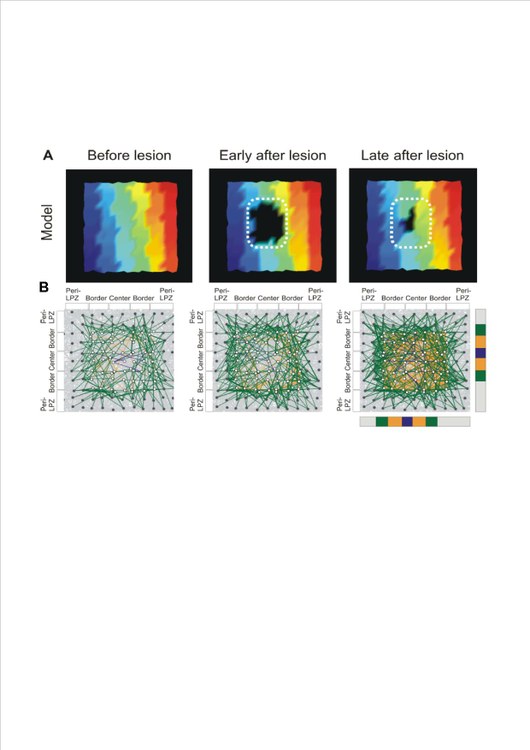Novel self-organizing rules for retinotopic remapping
Filed under:
Computational neuroscience
Markus Butz (Ruhr-University Bochum), Arjen van Ooyen (VU Amsterdam)
Retinotopic maps in the primary visual cortex are plastic even in the mature brain. Particularly after permanent changes in external input, i.e. after focal retinal lesions, maps in the cortex adapt so that neurons deprived of input (lesion projection zone, LPZ) become responsive to adjacent input representations. This 'filling-in' process is currently explained by STDP. However, STDP is a fast process while the time course of reorganization continues over weeks up to one year [1]. Recent data indicate that structural plasticity (forming new synapses, breaking old ones) is involved in this reorganization [2,3] and acts very much on the same timescale. Therefore, we propose the first model investigating structural plasticity in application to cortical remapping. The model implements local activity-dependent rules for changes in the morphology of the neuron. In accordance with experimental findings, model neurons aim to maintain their electrical activity on average at a certain pre-defined set-point [4] by adapting the number of contact sites (axonal and dendritic elements). New (vacant) synaptic elements are offered to the network and connect to form synapses. The probability for synapse formation between two neurons depends on the amounts of vacant synaptic elements offered, and on the Euclidean distance between the two neurons. Network rewiring is therefore a reciprocal process between activity and network structure: Activity levels inside the LPZ (low) and outside the LPZ (high) locally induce the formation of axonal and dendritic elements, respectively, that in turn form synapses in a cooperative and compensatory manner leading to increasing activities in the LPZ again. The consequence of transporting activities via new synapses from the outside of the LPZ into the LPZ is an enlargement of input representation from intact areas and a sequential filling-in of the LPZ (Fig.1)—by contrast not obtained in self-organizing maps. The novelty of the model is to generate predictions how local cellular responses lead to rewiring and remapping on an anatomical network level.
Literature:
[1] Giannikopoulos, D.V., Eysel, U.T. (2006) Proc Natl Acad Sci U S A, 103(28):10805-10.
[2] Keck, T. et al. (2008) Nat. Neurosci. 11: 1162-1167.
[3] Yamahachi, H. et al. (2009) Neuron 64:719-729.
[4] Butz M et al. (2009) Front Comput Neurosci. 2009;3:10.
Literature:
[1] Giannikopoulos, D.V., Eysel, U.T. (2006) Proc Natl Acad Sci U S A, 103(28):10805-10.
[2] Keck, T. et al. (2008) Nat. Neurosci. 11: 1162-1167.
[3] Yamahachi, H. et al. (2009) Neuron 64:719-729.
[4] Butz M et al. (2009) Front Comput Neurosci. 2009;3:10.

Preferred presentation format:
Poster
Topic:
Computational neuroscience

 Latest news for Neuroinformatics 2011
Latest news for Neuroinformatics 2011 Follow INCF on Twitter
Follow INCF on Twitter
